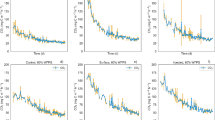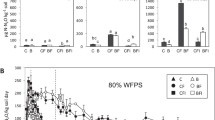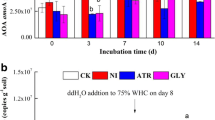Abstract
The objective of the present study was to evaluate the impact of the treatment of slurry liquid fraction (LF) acidified to pH 5.5 (ALF) on nitrification and denitrification processes after soil application. The impact of such treatment was compared with that of untreated LF, LF treated with a nitrification inhibitor (3,4-Dimethylpyrazole phosphate (DMPP)) (LF + DMPP). An incubation was conducted using the denitrification incubation system (DENIS/gas-flow-core technique) at a constant temperature of 20 °C and lasted for 32 days in order to follow nitrogen dynamics and gaseous emissions (N2O, NO, CO2) from soil. Inhibition of ammonium nitrification and nitrate accumulation was evident in both LF + DMPP and ALF at the top soil (0–3.75 cm) and those effects were stronger in the LF + DMPP. Denitrification was the main source of N2O emissions from soils amended with treated and untreated LF. Compared to the untreated LF, the ALF significantly reduced the total N lost as N2O from 0.10% to 0.05% of the applied N whereas the DMPP reduced the total N lost as N2O from 0.10% to 0.07%. Relative to the untreated LF, the ALF reduced the total N lost as NO emissions from 0.03% to 0.02% of the applied N whereas DMPP addition led to a stronger decrease from 0.03% to 0.01%. Both, ALF and LF + DMPP had no impact on CO2 emissions relative to the untreated LF. The ALF reduced CO2 emissions by 19% relative to the LF + DMPP. Our results demonstrate that slurry acidification affect not only nitrification but also the denitrification process. This suggests that slurry acidification is a valid technique to minimize N emissions.


Similar content being viewed by others
References
Cárdenas LM, Hawkins JMB, Chadwick D, Scholefield D (2003) Biogenic gas emissions from soils measured using a new automated laboratory incubation system. Soil Biol Biochem 35:867–870
Cheng Y, Wang J, Wang SQ, Zhang JB, Cai ZC (2014) Effects of soil moisture on gross N transformations and N2O emission in acid subtropical forest soils. Biol Fertil Soils 50:1099–1108
Fangueiro D, Ribeiro H, Vasconcelos E, Coutinho J, Cabral F (2009) Treatment by acidification followed by solid–liquid separation affects slurry and slurry fractions composition and their potential of N mineralization. Bioresour Technol 100:4914–4917
Fangueiro D, Ribeiro H, Coutinho J, Cardenas L, Trindade H, Cunha-Queda C, Vasconcelos E, Cabral F (2010) Nitrogen mineralization and CO2 and N2O emissions in a sandy soil amended with original or acidified pig slurries or with the relative fractions. Biol Fertil Soils 46:383–391
Fangueiro D, Coutinho J, Cabral F, Fidalgo P, Bol R, Trindade H (2012) Nitric oxide and greenhouse gases emissions following the application of significantly different cattle slurry particle size fractions to soil. Atmos Environ 47:373–380
Fangueiro D, Surgy S, Coutinho J, Vasconcelos E (2013) Impact of cattle slurry acidification on carbon and nitrogen dynamics during storage and after soil incorporation. J Plant Nutr Soil Sci 176:540–550
Fangueiro D, Hjorth M, Gioelli F (2015a) Acidification of animal slurry–a review. J Environ Qual 149:46–56
Fangueiro D, Surgy S, Fraga I, Cabral F, Coutinho J (2015b) Band application of treated cattle slurry as an alternative to slurry injection: implications for gaseous emissions, soil quality, and plant growth. Agric Ecosyst Environ 211:102–111
Fangueiro D, Pereira J, Bichana A, Surgy S, Cabral F, Coutinho J (2015c) Effects of cattle-slurry treatment by acidification and separation on nitrogen dynamics and global warming potential after surface application to an acidic soil. J Environ Manag 162:1–8
Fangueiro D, Surgy S, Fraga I, Monteiro FG, Cabral F, Coutinho J (2016) Acidification of animal slurry affects the nitrogen dynamics after soil application. Geoderma 281:30–38
Firestone MK, Davidson EA (1989) Microbial basis of NO and N2O production and consumption in soil. In: Andreae MO, Schimel DS (eds) Exchange of trace gases between terrestrial ecosystems and the atmosphere. Wiley, New York
Gandhapudi SK, Coyne MS, D’Angelo E.M, Matocha C (2006) Potential nitrification in alum-treated soil slurries amended with poultry manure. Bioresour Technol 97:664–670.
Hatch D, Trindade H, Cardenas L, Carneiro J, Hawkins J, Scholefield D, Chadwick D (2005) Laboratory study of the effects of two nitrification inhibitors on greenhouse gas emissions from a slurry-treated arable soil: impact of diurnal temperature cycle. Biol Fertil Soils 41:225–232
Hjorth M, Christensen KV, Christensen ML, Sommer SG (2010) Solid–liquid separation of animal slurry in theory and practice. A review Agron Sustainable Dev 30:153–180
Houba VJG, van der Lee JJ, Novozamsky I, Walling I (1989) Soil and plant analysis, part 5, soil analysis procedures. Wageningen Agricultural University, Wageningen, The Netherlands
Jensen LS (2013) Animal manure fertiliser value, crop utilisation and soil quality impacts. In: Sommer SG, Christensen ML, Schmidt T, Jensen LS (eds) Animal manure recycling: treatment and management, 1st edn. Wiley, United Kingdom, pp 295–328
Loick N, Dixon ER, Abalos D, Vallejo A, Matthews GP, McGeough KL, Well R, Watson CJ, Laughlin RJ, Cardenas LM (2016) Denitrification as a source of nitric oxide emissions from incubated soil cores from a UK grassland soil. Soil Biol Biochem 95:1–7
Maienza A, Bååth E, Stazi SR, Benedetti A, Grego S, Dell’Abate MT (2014) Microbial dynamics after adding bovine manure effluent together with a nitrification inhibitor (3, 4 DMPP) in a microcosm experiment. Biol Fertil Soils 50:869–877
Menéndez S, Merino P, Pinto M, González-Murua C, Estavillo JM (2009) Effect of N-(−butyl) Thiophosphoric Triamide and 3, 4 dimethylpyrazole phosphate on gaseous emissions from grasslands under significantly different soil water contents. J Environ Qual 38:27–35
Merino P, Estavillo JM, Besga G, Pinto M, González-Murua C (2001) Nitrification and denitrification derived N2O production from a grassland soil under application of DCD and Actilith F2. Nutri Cycl Agroecosyst 60:9–14
Merrington G, Nfa LW, Parkinson R, Redman M, Winder L (2002) Agricultural pollution: environmental problems and practical solutions. Spon Press, New York
Ottosen LD, Poulsen HV, Nielsen DA, Finster K, Nielsen LP, Revsbech NP (2009) Observations on microbial activity in acidified pig slurry. Biosyst Eng 102:291–297
Pereira J, Fangueiro D, Chadwick DR, Misselbrook TH, Coutinho J, Trindade H (2010) Effect of cattle slurry pre-treatment by separation and addition of nitrification inhibitors on gaseous emissions and N dynamics: a laboratory study. Chemosphere 79:620–627
Ravishankara AR, Daniel JS, Portmann RW (2009) Nitrous oxide (N2O): the dominant ozone-depleting substance emitted in the twenty-first century. Science 326:123–125
Rochette P, Angers DA, Coté D (2000) Soil carbon and nitrogen dynamics following application of pig slurry for the 19th consecutive year: carbon dioxide fluxes and microbial biomass carbon. Soil Sci Soc Am J 64:1389–1395
Ruser R, Schulz R (2015) The effect of nitrification inhibitors on the nitrous oxide (N2O) release from agricultural soils—a review. J Plant Nutr Soil Sci 178:171–188
Shi X, Hu H, He J, Chen D, Suter HC (2016) Effects of 3,4-dimethylpyrazole phosphate (DMPP) on nitrification and the abundance and community composition of soil ammonia oxidizers in three land uses. Biol Fertil Soils 52:927–939
Smith KA, Ball T, Conen F, Dobbie KE, Massheder J, Rey A (2003) Exchange of greenhouse gases between soil and atmosphere: interactions of soil physical factors and biological processes. Eur J Soil Sci 54:779–791
Sommer SG, Clough TJ, Chadwick D, Petersen SO (2013) Greenhouse gas emissions from animal manures and technologies for their reduction. In: Sommer SG, Christensen ML, Schmidt T, Jensen LS (eds) Animal manure recycling: treatment and management, 1st edn. Wiley, United Kingdom pp, pp 177–194
Sørensen P, Jensen LS (2013) Nutrient leaching and runoff from land application of animal manure and measures for reduction. In: Sommer SG, Christensen ML, Schmidt T, Jensen LS (eds) Animal manure recycling: treatment and management, 1st edn. Wiley, United Kingdom pp, pp 195–210
Wenzel H, Petersen BM (2009) Life cycle assessment of slurry management technologies. Environmental Project No. 1298. Danish Ministry of the Environment, Environmental Protection Agency, Copenhagen, Denmark
Williams EJ, Hutchinson GL, Fehsenfeld FC (1992) NOx and N2O emissions from soil. Glob Biogeochem Cycles 6:351–388
Acknowledgements
The research leading to these results has received funding from the People Programme (Marie Curie Actions) of the European Union’s Seventh Framework Programme FP7/2007-2013/ under REA grant agreement n° [289887] and FCT (PTDC/AGR-PRO/119428/2010), UID/AGR/04033/2013 and POCI-01-0145-FEDER-006958. Rothamsted Research receives strategic funding by the Biotechnology and Biological Sciences Research Council (BBSRC, Grant number BB/J004286/1). This study was also part funded by BBSRC project grant BB/K001051/1. The findings of this study reflect only the author’s view and that the Union is not liable for any use that may be made of the information contained therein.
Author information
Authors and Affiliations
Corresponding author
Rights and permissions
About this article
Cite this article
Owusu-Twum, M., Loick, N., Cardenas, L.M. et al. Nitrogen dynamics in soils amended with slurry treated by acid or DMPP addition. Biol Fertil Soils 53, 339–347 (2017). https://doi.org/10.1007/s00374-017-1178-0
Received:
Revised:
Accepted:
Published:
Issue Date:
DOI: https://doi.org/10.1007/s00374-017-1178-0




